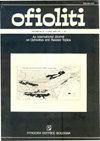巴尔干半岛中部特提斯缝合带古生代单元的变形模式:来自塞尔维亚bukulja-lazarevac古生代单元研究的新认识
IF 1.3
4区 地球科学
Q2 GEOLOGY
引用次数: 11
摘要
本文提出并讨论了Bukulja-Lazarevac古生代单元(BLPz)的岩性和变形样式的新资料,并将其与巴尔干半岛中部复合体缝合带邻近的Drina-Ivanjica单元(DIU)、Jadar地块(JBU)和Diaina古生代单元(DPz)的特征进行了比较。该区由绿片岩相条件下变质的4个变质沉积和变质岩组组成。只有少数岩石显示出角闪岩相条件较早变质的证据。BLPz在岩性上与DIU和DPz相似,而JBU则不同。变形研究表明,BLPz岩石经历了两次韧性构造事件(D1和D2)和一次脆性构造事件(D3)。D1结构为小型等斜和斜褶皱,铰链为亚圆形,统计B1轴向E-ESE和SE倾斜约5- 200度。D2构造表现为在较大褶皱构造的分支上形成的m- dm大小的褶皱。从统计上看,B2轴主要向东南偏斜,其次为NW和SW。B1和B2轴之间的夹角是均匀的,从35°到45°。在DIU、JBU和DPz也记录了两个类似的变形事件的证据。将B1轴的测量方向绕B2折叠轴的统计方向旋转,重建B1轴的原始位置。结果表明,DIU (Drina地块)北部的B1轴与JBU具有相同的主取向,走向NE-SW。DIU南部(Ivanjica地块)和BLPz单元以东西向B1构造为特征。这种组织表明,所有研究的古生代单元可能都经历了类似的韧性变形事件。这些结果支持了这些单元是亚德里亚大陆整体组成部分的假设,并在侏罗纪后推覆体叠加中得到了它们现在的关系。本文章由计算机程序翻译,如有差异,请以英文原文为准。
DEFORMATION PATTERN OF THE PALAEOZOIC UNITS OF THE TETHYAN SUTURE IN THE CENTRAL BALKAN PENINSULA: A NEW INSIGHT FROM STUDY OF THE BUKULJA-LAZAREVAC PALAEOZOIC UNIT (SERBIA)
This study presents and discusses new data about the lithology and deformation style of the Bukulja-Lazarevac Palaeozoic Unit (BLPz) and compares its characteristics to those exhibited by the adjacent Palaeozoic units of the complex suture of the central Balkan Peninsula, namely: the Drina-Ivanjica (DIU), the Jadar Block (JBU) and the Diaina Palaeozoic (DPz) Units. The BLPz consists of four metasedimentary and metaigneous formations metamorphosed under greenschist facies conditions. Only rare rocks show evidences of an earlier metamorphism of amphibolites facies conditions. The BLPz is lithologically similar to DIU and DPz whereas JBU is different. The study of deformation suggests that BLPz rocks underwent two ductile tectonic events, referred to as D1 and D2, and one brittle event, referred to as D3. The D1 structures are small-scale isoclinal and oblique folds with subrounded hinges and statistical B1 axes dipping around 5-20o towards E-ESE and SE. The D2 structures appear as m- to dm-sized folds formed on the limbs of the larger fold structures. Statistically, B2 axes are mainly dipping to SE, subordinately to NW and SW. The angle between B1 and B2 axes is uniform ranging from 35o to 45o. Evidences for two similar deformation events are recorded in DIU, JBU and DPz, as well. Reconstruction of the original position of B1 axes was made by rotating their measured directions around the statistic directions of B2 fold axes. The obtained results imply that the B1 axes in the northern part of DIU (Drina Block) and JBU have the same primary orientation striking NE-SW. The southern part of DIU (Ivanjica Block) and BLPz Units are characterized by E-W oriented B1 structures. Such organization suggests that all the studied Palaeozoic units probably underwent similar events of ductile deformation. These results argue in favor of the hypothesis that these units represented integral parts of Adria, and obtained their present relationships during post-Jurassic nappe stacking.
求助全文
通过发布文献求助,成功后即可免费获取论文全文。
去求助
来源期刊

Ofioliti
地学-地质学
CiteScore
2.40
自引率
7.70%
发文量
1
期刊介绍:
Since 1976, Ofioliti provides an international forum for original contributions and reviews in the field of the geodynamics, petrology, geochemistry, biostratigraphy, stratigraphy, tectonics and paleogeography applied to ophiolitic terrains and modern oceanic lithosphere, including their sedimentary cover. Studies of topics such as geodynamics of the mantle, the evolution of orogens including ophiolites and paleoceanography are also welcome
 求助内容:
求助内容: 应助结果提醒方式:
应助结果提醒方式:


